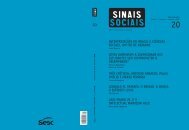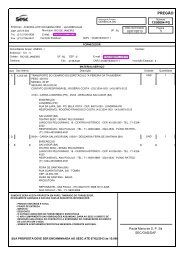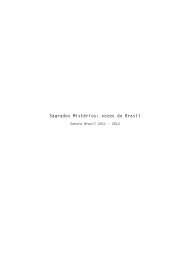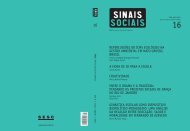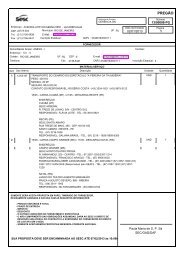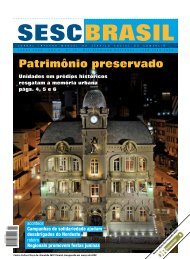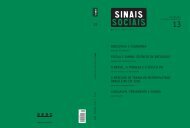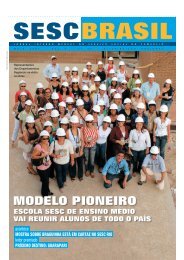Revista Sinais Sociais N12 pdf - Sesc
Revista Sinais Sociais N12 pdf - Sesc
Revista Sinais Sociais N12 pdf - Sesc
You also want an ePaper? Increase the reach of your titles
YUMPU automatically turns print PDFs into web optimized ePapers that Google loves.
Este artigo tem como objetivo analisar a evolução da taxa de desemprego padrão<br />
no Brasil durante a última década, assim como de duas novas formas de<br />
defi nição deste indicador. A primeira inclui os indivíduos classifi cados como<br />
marginalmente ativos, ou seja, pessoas que estão disponíveis para trabalhar,<br />
mas na semana de referência não buscaram ativamente emprego, e a segunda<br />
inclui os trabalhadores subocupados por insufi ciência de horas trabalhadas,<br />
pessoas consideradas ocupadas na semana de referência, mas que gostariam e<br />
estavam disponíveis para trabalhar mais horas que as efetivamente trabalhadas.<br />
A análise empírica é realizada para as seis regiões metropolitanas de abrangência<br />
da Pesquisa Mensal de Emprego entre 2003 e 2009, tanto em termos agregados<br />
quanto segundo o gênero, a idade e a escolaridade dos indivíduos. Os<br />
resultados mostram que a proporção de desempregados em termos agregados<br />
seria cerca de duas vezes maior se fossem incluídos os marginalmente ativos e<br />
os subocupados por insufi ciência de horas. Além disso, as reduções da taxa de<br />
desemprego padrão observadas ao longo do tempo são acompanhadas de quedas<br />
tanto na proporção de marginalmente ativos quanto na de subocupados<br />
por insufi ciência de horas trabalhadas.<br />
Palavras-chave: taxa de desemprego; indicadores; Brasil<br />
This article aims to analyze the evolution of the standard unemployment rate<br />
in Brazil during the last decade, as well as two new ways of defi ning this indicator.<br />
The fi rst includes individuals classifi ed as marginally attached to the labor<br />
market, or people who are available to work, but in the reference week did not<br />
actively sought employment, and the second includes workers underemployed<br />
due to insuffi ciency of hours worked, people considered employed in the reference<br />
week, but they would and were available to work more hours than<br />
actually worked. The empirical analysis is performed for the six metropolitan<br />
areas of PME between 2003 and 2009, both in aggregate and according to<br />
gender, age and education of individuals. The results show that the proportion<br />
of unemployed in the aggregate rate would be about two times higher if this included<br />
the marginally attached and the underemployed due to insuffi ciency of<br />
hours worked. In addition, reductions in standard unemployment rate observed<br />
over time are accompanied by declines in both the proportion of marginally<br />
attached as the underemployed due to insuffi ciency of hours worked.<br />
Keywords: unemployed rate; indicators; Brazil<br />
SINAIS SOCIAIS | RIO DE JANEIRO | v.4 nº12 | p. 90-121 | JANEIRO > ABRIL 2010<br />
91




